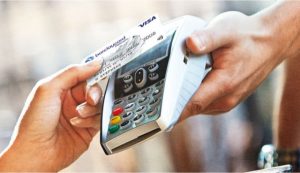The conditions for the widespread adoption of contactless payments using chip cards are in place, asserts a new report from the Federal Reserve Bank of Boston. But when that will happen and what will trigger it are unknown in the Fed report, “Tap to Pay: Will Contactless Cards Pave the Way for NFC Mobile Payments in the U.S.?” released this week.
“The rest of the developed world is contactless,” says Marianne Crowe, vice president of payment strategies at the Boston Fed. “It’s becoming a need for us to become current with the rest of the world as well.”
The U.S. payment card industry finally took a big step in that direction in 2015 when financial institutions began issuing EMV chip cards in earnest. Now, the industry is promoting contactless EMV payments as the next step. The effort is aided by a number of large issuers, such as JPMorgan Chase & Co., committing to issue chip cards with contact and contactless interfaces. Most EMV point-of-sale terminals placed at merchant locations in the last several years are contactless-capable, though not all merchants have activated the function.

One question Crowe, report author along with Elisa Tavilla, a Boston Fed industry consultant in payment strategies, wanted to examine is the relation between contactless cards and mobile payments.
“There are always people who like using their cards and will continue to use a card,” Crowe says. “Those people will probably adapt easily to contactless cards. It’s quicker and easier than inserting the chip.”
As for mobile payments, uncertainty about additional user growth abounds. Earlier this year, only 14% of U.S. smart-phone users made a mobile payment with one of the “Pays,” the collective term for the three tech-based mobile-payments services, said Juniper Research.
Will contactless cards spur mobile payments growth? Possibly, because more merchants might activate the contactless function. “Even though Apple Pay and other NFC wallets have been around for a while, not all consumers have tried using them,” Crowe says. “But, with the card, everyone will have the option of using it by tapping or inserting it.” EMV contactless cards and mobile-payments wallets use the same near-field communication radio frequency technology.
But there could be a gain for contactless cards regardless. A consumer might attempt to pay with a mobile wallet, only to discover the POS terminal is not contactless-enabled. If a consumer does that with a contactless card, it’s easy enough to dip the same card into the reader to complete the transaction, the report says. “This uncertainty may drive consumers to use a contactless card, at least in the short-term, because they know it will work each time they pay. The simplicity of using contactless cards may also appeal to a broader consumer audience that includes those who are less tech-savvy,” the report says.
Crowe and Tavilla also say that the current contactless payment push stands a better chance of success than the card industry’s previous effort in the mid-2000s. The big difference now is that many merchants have POS terminals that, if not already activated for contactless payments, can easily be made so, and that don’t require special readers.
“The market seems more prepared,” Tavilla says. Most consumers have phones with NFC capability and the cost of dual-interface cards has come down. A non-printed, non-personalized contact-only EMV card may sell for less than 50 cents. A dual-interface card may be approximately $1, or less with volume orders.





